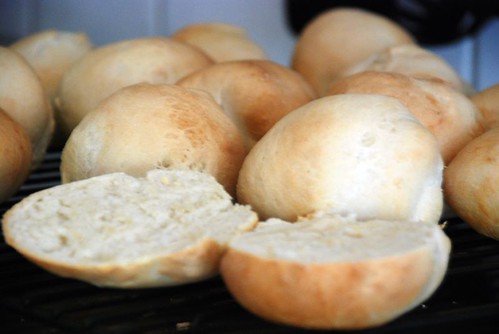
Cold rising is so convenient when baking. it means that instead of letting your dough prove at room temperature for an hour or two, you let it rest for much longer, in the fridge. And it's not only convenient, it actually makes for a very tasty bread too.
I've found that you can't just take any recipe and let it rise cold overnight - but some recipes work very well, and I haven't tried enough to know for sure what works or doesn't work. But this one, this one works oh so well. This is perfect for a weekend breakfast - just make the dough tonight, and you'll have freshly baked bread tomorrow morning! Ah, the wonder!
The stronger flour you use here, the more gluten development you will get, and that in turn gives you a chewier bread. I recommend Manitoba Cream flour for those Swedes that can get it, or Vetemjöl Special. Or whatever strong bread flour you happen to have.
Cold-risen Bread
Makes 15
50 g fresh yeast
500 ml (2 cups) cold water
1 tbsp sugar
1,5 tbsp salt
1 tbsp neutral oil
1 kilo strong flour
Crumble the yeast into a bowl. Add water, sugar, salt and oil and mix. Add the flour gradually, and work by hand or with a machine for at least ten minutes. (I had my Kitchen-Aid on the lowest setting for five minutes, and five more on the next setting.) The dough should be very elastic and hard, not sticky.
Put the dough in a clean bowl, and cover lightly with a tiny bit of oil. Cover with clingfilm and leave to rise in the fridge overnight. (A plastic box with a lid works very well too.)
On the next day, roll the dough into small buns, put on a cookie sheet and leave to rise at room temperature for about 40 minutes. Bake at 225°C for 12-15 minutes.
Recipe in Swedish:
Kalljästa frallor

9 comments:
You learn a new thing every day - on this blog at least!.
I will try this out.
Charlotte
That bread looks delicious!
I have stopped using warm milk(or water or whatever you choose as liquid in bread of yeasted pastries) completely since slow proving does enhance flavour.
Cold-risen bread is also convenient in that it makes you feel as if it is not as arduous as it might seem if you did it all at one time.
Oh, this is just perfect for those hot, hot days when you want maximum flavor with minimum fuss. I must give it a try.
Cheers!
Just a small correction: bread and dough are proofed, not proved. The process is called "proofing" and not "proving". Too bad many sites are using the incorrect vocabulary and then it trickles down and becomes the norm, it seems. In any case, an excellent recipe and I approVE of cold PROOFING. My baguettes are exquisite after I cold proof the dough.
Happy weekend! And thank you.
Anna
Did you ever make sesame buns?? Just wondering!
This is excellent. I do agree that long proofing is really good for bread! :)
Anna - thank you, one of those little things that's hard to pick up for a foreign speaker, I suppose :) I've kept to writing "rise" instead - it's more close to the Swedish translation, anyway.
Jelly - I did, and they were delicious!! I wonder if they're hard to make from scratch, do you know?
Hi Anne! I don't know about making them from scratch, but I'll ask my co-workers on Monday!
Post a Comment